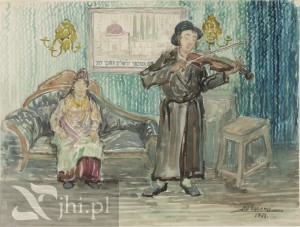Two things about this post today. First, an excerpt from Surviving Hitler in Poland: One Jew’s Story, a memoir written by Moshe Rynecki’s son, George. These three paragraphs are from a chapter titled, “My Father was a Painter.” Second, below is a photograph of a Moshe Rynecki painting held by the Jewish Historical Institute (ZIH) in Warsaw. I saw this photograph for the first time last week when the museum emailed me photos of 17 of the 52 Rynecki pieces held in their collection. I wonder if this piece might have been painted inside his home at 24 Krucza Street in Warsaw. The painting was acquired by ZIH in 1946. The painting is dated 1934. ZIH has titled it, “Zyd skrzypek,” which I believe this roughly translates to Jewish Violinist.
My father’s paintings were shown in the Museum of Art in Warsaw, and a certain year, I think 1923, he was free to hang any of his works, without a jury. Only achieved masters could get this right. Polish schools of art and Polish artists, are recognized and known all over Europe. They had great masters, and I believe they still are great achievers in the world of art. Father was very sensitive as artists go. He couldn’t stand the ones who were trying to impress without having a true thing to show. He expected the ones who would experiment in new forms of art to know or be proficient in true old forms first. It actually didn’t make much difference if the art was music, literature, or drawing. Only people with some honest background and approach would be allowed to argue with him, or show their knowledge.
My father was 5’6″, of slim stature, with good facial features. He cared little for clothing. Wore a small beard and mustache. At the final part of his life he took the hair off his face completely. His attachment to his family, children, and wife was total. I don’t think he had ever any affairs beyond home. His life, although not simple, was fairly well regulated. The Germans never broke his spirit. He painted to the very end, and in his way wrote the history of the ghetto where he was displaced in 1940 and deported to Majdanek, near Lublin, in 1943, where most probably he was executed by the Germans in a gas chamber. He believed to the end that no matter what, the Germans were of too high culture to do the things they did. He represented, in a way, the mind of the Jewish people. They all believed the Germans. They all have made that massive mistake.
I was, of course, of a different state of mind. I knew deep in my heart that the human cannot be trusted. I told him so in 1943 over the telephone, but he would only say, “If you are right my son, then let me go where my brothers and sisters go. And if it’s death, so be it.” I could get him out, and maybe save him. He didn’t agree. My mother listened to me, got out of the ghetto in 1942 and spent the war years in peace hidden with a Polish lady, a certain Komarnicka, in a suburb of Warsaw, who did it for money. My mother survived the war, was liberated by the Russians, and in 1947 found me and my family in Italy. It was my mom who brought the remnants of the paintings to Italy. (page 63)
